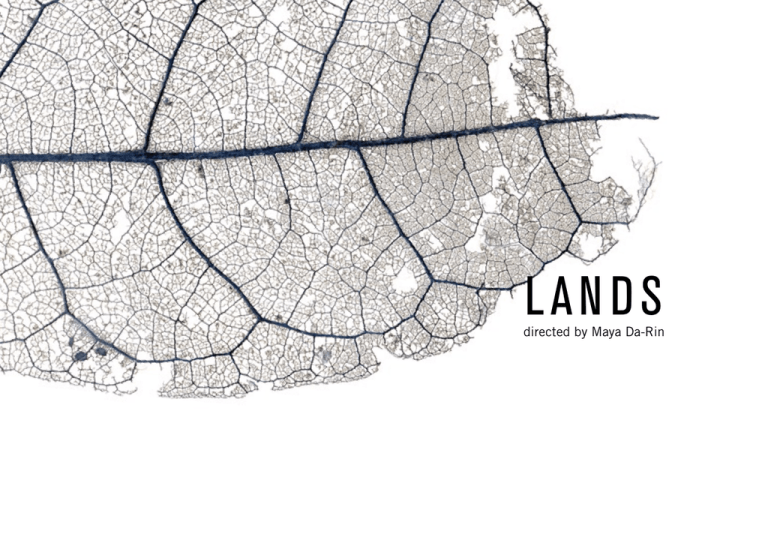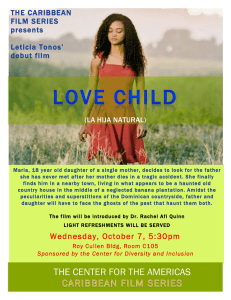directed by Maya Da-Rin
advertisement

LANDS directed by Maya Da-Rin “A gorgeous work of art. (…) Maya Da-Rin’s Lands marks the addition of another strong voice to the roster of Brazilian nonfiction filmmakers.” Robert Koehler, Variety Synopsis On the triple frontier between Brazil, Colombia and Peru, the twin towns of Letícia and Tabatinga form an urban island surrounded by the Amazon rain-forest. Following the ordinary events and the constant come and go of people along the border, Lands portrays the presence and the influence of the frontier on the lives of its inhabitants. 1 The film “Brazil has been dislocated to the Amazon. The Amazon rarely conjures up urban images in Everything happens there, drug trafficking goes those who do not know it. Maybe for this reason through there, economic interests are there, a lot the first contact with the twin cities Tabatinga of capital is flowing that way, as well as concerns (Brazil) and Leticia (Colombia), and the village regarding ecology, the world’s viewpoint, the Santa Rosa (Peru) is so surprising. Cut-off from paranoia and the illusion about paradise, the economic centers of its respective countries everything is there or turned in that direction. by the forest and the distance, this triple border For better or worse, the Amazon has become the is characterized by the constant transit of place of all places, and a great cultural melting people and exchange of goods, the incessant pot is brewing over there, and from down here sound of motorcycles and radios, the mixture of we have no idea what’s going on.” traditional and technological knowledge and the Eduardo Viveiros de Castro, in interview to coexistence of different cultures and ethnicities. Azougue magazine Lands proposes a reflection about some of the borders’ manifestations through encounters with some of its inhabitants. Manoel works at the Tabatinga port and takes passengers and goods back and forth between Brazil and Peru in his motorboat. Willian, Raul and Carlos are taxi drivers who 3 daily transport the population across the border 4 Lands slowly reveals the various daily rhythms that separates the twin cities. Basilia belongs in Tabatinga, Leticia and Santa Rosa: the currents to the Bora Colombian people and frequently of the Solimões river observed from Manoel’s visits relatives in villages situated in the three boat; the immense forest that reveals itself before countries, questioning the notion of nationality Basilia’s fast pace; the hammock rocking to the and territorial limits imposed by the borders. rhythm of the Christian hymn sung in Tikuna Irene, Basilia’s cousin, lives in the forest in the by Florentino’s children; the concentration and outskirts of Leticia and every Saturday walks silence of Francisco’s patients while taking their along the 20 km between her house and the Ayahuasca doses, preparing themselves to cross a city, taking pupunha fruit to be sold in the spiritual border instead of a concrete one. market. Florentino, a Tikuna bilingual teacher The film maps out the demarcations that, in the Umariaçu village, battles an intense although not always visible, are present in transformation process due to the proximity of people’s daily lives. The main character in the indigenous area and the city of Tabatinga. Lands is the border itself, multiple, complex Francisco gives new meaning to traditional and indefinable by a singular point of view. The curing rites. Along with his wife, Celina, he borders, after all, are everywhere and nowhere receives patients for the rituals he conducts using in this region, at the same time preventing and the Ayahuasca plant in the backyard of his house promoting circulation. in Tabatinga. The border Situated side by side, on the same riverbank There is a constant exchange of goods, languages of the Solimões, Tabatinga and Leticia are and knowledge, not only between the two cities, integrated although belonging to different but also between the different countries, the national territories. The twin cities have close city and the forest, the indigenous lands and the economic ties and are connected by a single national territories. The triple border is a place avenue. A post with two flags signals the place of confluence and contact, which reveals both where Amizade avenue (Brazil) becomes the similarities and the differences between three Internacional avenue (Colombia). On the other South American countries. bank of the river, at a few minutes distance by boat, is Santa Rosa village, in Peruvian territory. Different from Tabatinga, which is practically unknown by Brazilians from other regions, Leticia is the capital of the Amazonas state, in Colombia. Both cities are home to many Peruvian immigrants and Colombian desplazados that are fleeing from the Farc guerrilla armed conflicts. Indigenous people of different ethnicities that live in villages or reserves around also circulate in the markets and ports. 7 8 Research Shooting Lands started to be developed in 2004. The The shoot started in November 2006 and took six initial phases of research were carried out in weeks. Its duration allowed the wait and observa- collaboration with Luiza Leite, Daniel Bueno, tion that were crucial for the making of Lands. Pedro Cesarino and Geraldo Pereira. In July There was no shooting script, but narrative 2005, Maya Da-Rin travelled to the border. She options that gave direction to the crew’s work. In lived in Leticia for two months and travelled Lands, the intention was to think the concept of through the region. border beyond its concrete manifestations. The This first trip allowed the director to become film portrays some of the more subtle aspects of familiar with some aspects of the border that the triple border: the maps drawn by the lichen would later be implicated in the choices made on the bark of the trees, the facial traits of people during the shoot. from different origins, the sound of various languages mixed together and the musical rhythms from each country blaring from bars and restaurants. Editing Sound design The script was developed during the editing by The soundtrack, created by musician Edson Karen Akerman, Maya Da-Rin and Joaquim Secco by using local sounds, dialogues with the Castro. Its structure is centered on the encounters geographical spaces presented in the film. It was with some of the border’s inhabitants and their elaborated upon the transformation and fusion daily transit. of ambient sound recorded during the shoot The territorial border is a starting point for and musical harmonies composed in studio. The the portrayal of issues such as the relationship creation of the musical themes was intrinsic to between the cities and the Amazon rainforest the sound design and conceived together and today, the contact between traditional indigenous simultaneously with it. cultures and contemporary modes of life, and the exchange between three South American countries. 9 Approach according to Maya Da-Rin “Lands was born out of the desire to shoot 10 The traveling takes allude to the sensation of transition spaces. It is a film about fissures, gaps flow and transit, so common in the border. The and also confluences. When I arrived at the fixed camera takes emphasize belonging and the border, I saw a multiple reality, where ancestral relationship of the people with the territory. The and contemporary cultures mutually influence sound, rhythm, texture and colors of the film one another. The land, which is usually perceived compose a personal approach through which I as a material possession and a political territory, attempt to get closer to a region both distant and has a spiritual connotation to many indigenous familiar to me.” peoples. The film gradually reveals that the border as well as the land are present in different ways in its region’s geography – the city, the forest and the river – and the people’s daily movement through these spaces. Maya Da-Rin Cineluz director production company Born in Rio de Janeiro in 1979, Maya Da-Rin Founded in 1992, Cineluz has attained works as film director and editor. Her work as recognition in the Brazilian cinematographic a filmmaker includes the documentaries The market for its prize-winning documentaries and World Tilts to Here and Margin, both awarded by feature films. the Itaú Cultural Institute, and Lands, her first The company has produced more than ten feature-length film. Her films were programmed documentary films, among which, Kids’ War, at several film festivals and museums worldwide, prize winner at the Amsterdam International as the 63 Film Festival Locarno, Switzerland; Documentary Film Festival, Havana and 52 Leipzig Film Festival, Germany; 19 Gramado Festival; and Meninas, programmed at Rencontres Cinémas d’Amérique Latine de the Berlin Film Festival. rd nd th Toulouse, France; 25th Guadalajara International Amongst the fiction films produced by Film Festival, Mexico; 33 São Paulo International Cineluz are Stolen Dreams, awarded best film by Film Festival, Brazil; 29 Festival del Nuevo Cine the popular jury at Rio Film Festival; Cazuza, Latino Americano, Cuba; 29 São Paulo Art Time Doesn’t Stop, the biggest Brazilian box office Biennial, and the museums MoMA and New hit in 2004; Possible Loves, a Sundance (2001) Museum, New York. This year she’ll be entering and Miami Film Festival (2001) prize winner; and the two-year artistic residency at the Le Fresnoy Little Book of Love, the company’s first feature Studio of Contemporary Arts in France. length fiction film. rd th th 13 14 Awards Screenings 2010 2009 Cameras on Diversity Award, 25th Guadalajara 62nd International Film Festival Locarno, Switzerland, International Film Festival, Mexico, 2010 33rd São Paulo International Film Festival, Brazil Best Film, abcv Jury, 6th Panorama Internacional Coisa de Cinema, Brazil, 2010 Jury Special Award, 6 Panorama Internacional th Coisa de Cinema, Brasil, 2010 52nd International Leipzig Festival, Germany 2010 13th Tiradentes Film Festival, Brazil 10th Cinelatino, Germany 9th Tekfestival, Rome, Italy Best Film, 9th Filme Livre Festival, Brazil, 2010 3rd Human Rights Film Festival, Mexico City Nominated for Dirk Vandersypen Award, 20th Cine Ceará, Fortaleza, Brazil Belgium, 2010 8th Femina, Rio de Janeiro, Brazil 8th Premiere Brazil ny, MoMA, usa 3rd Wassermusik Festival, Berlin, Germany 2nd Ver e Fazer Filmes Festival, Cataguazes, Brazil New Museum of Contemporary Art, New York, usa 8th Vancouver Latin American Film Festival, Canada 11th Planet in Focus Film Festival, Toronto, Canada 1st Anaheim International Film Festival, usa 4th Novocine, Madri, Spain Fact sheet 16 Brazil, 2009 editor production company 75 min, 35 mm, color, Karen Akerman Cineluz Dolby Digital Maya Da-Rin director Maya Da-Rin producer Sandra Werneck assistant director Luiza Leite photography and camera Pedro Urano sound recording Bruno Vasconcelos Altyr Pereira Joaquim Castro sound design and original music Edson Secco executive producer Maya Da-Rin co-production Synapse sb tv Programming associate producers Labocine Alice Filmes support production director CTAv Mara Junqueira Quanta research Daniel Bueno Geraldo Pereira Luiza Leite Maya Da-Rin Pedro Cesarino Centro de Trabalho Indigenista Prefeitura de Tabatinga Rico Linhas Aéreas Bureau ­Cinema e Vídeo Cineluz [production company] Maya Da- Rin mwdarin@uol.com.br tel +55 21 2512 1770 mob +55 21 9649 5892 Primeiro Plano Comunicação [publicist] Anna Luiza Müller annaluiza@primeiroplanocom.com.br tel +55 21 2266 0524 mob +55 21 8272 4613 www.terrasfilme.com.br design Thiago Lacaz

